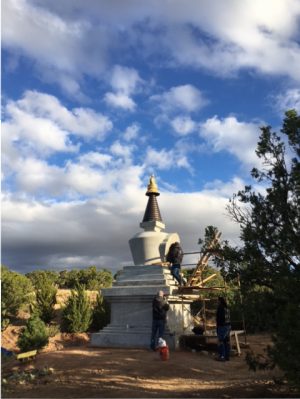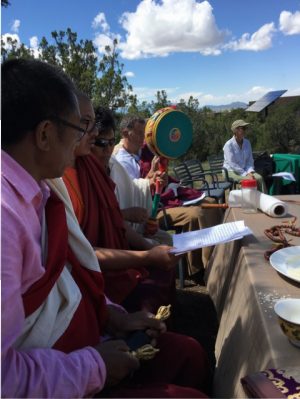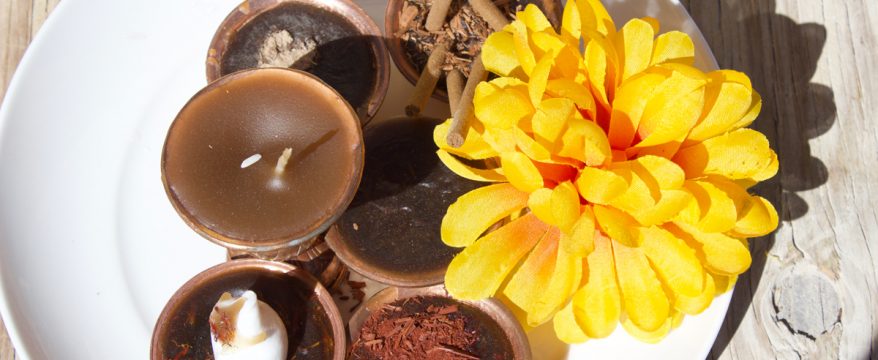A patient and timeless prayer that sustains…
The other day, I was speaking with Tina, a long-time Academy for the Love of Learning staff member and our bookkeeper. We had just finished the several day ‘filling the stupa’ ceremonies and Tina turned to me to say that she had a file marked “Stupa Budget” that went all the way back to early 2008! I had just been trying to recall exactly when it was that I first stated the intent to build a stupa on the Academy grounds. Tina helped solve the mystery: it was sometime in 2007 for it to have made it into our 2008 budget.10 years ago!
Reflecting back, I remembered the exact circumstances. I was standing out on Seton Village road, then a dirt road, across from where our Academy entrance gate is now located, looking up at the castle site and the castle remains, trying to figure out how in the world we would be able to make the original site work for the rebuild of the castle! We had so wanted to rebuild the castle – our intended Academy home. Having been nearly totally destroyed by fire on Nov 15, 2005, the castle remains, which were to be the foundation of the rebuild, no longer qualified as a historical property. To rebuild it, understandably, we were required to add an elevator, widen all of the doorways, staircases and hallways, etc. The result was an ever-expanding building plan. The original site just wasn’t big enough. It was as if trying to fit a size 10 foot into a size 6 shoe! Yet, we kept trying to make it work…we so wanted to rebuild the castle… It was, in retrospect, quite a lesson in attachment…!
So, standing out on the road by what is now our entrance gate – looking up at the old Castle site, my eyes slowly began to wander east, over to what is now our current site. I turned to David Gordon, the sculptor and Director of developing the Academy Center – and my key partner in designing the campus – and to Valmai Howe, the brilliant Feng Shui practitioner who helped us all along the way, and to our architects from Spears Architects, all of whom were there, and I asked the unasked question: ‘Why couldn’t we just build something completely new — over there – nestled into the side of that hill and give up on trying to re-create the castle on the original castle site? Maybe we could keep the castle remains and create a beautiful contemplative garden and outdoor space on the old site,’ I mused, ‘and, we’d be free then to do something completely new!’ The rebuild design was spreading more and more down the hill of the original site, in all directions, including to the west, down to the edge of the homes of Seton villagers. It felt disrespectful to me to build so close to our neighbors. Plus, I had begun to feel that ‘castles on hills’ were an old idea, somehow not really in the spirit of the emerging work of the Academy. An eco-sensitive building nestled into the side of a hill – interconnected with its natural surroundings – more of a feminine, relational gesture, made better sense.
Quickly, my imagination – and all of ours – began to take off with the new site in front of us beckoning and we began to see what could go where. David and Valmai immediately joined in filling out the picture. Once we were pretty much clear and felt agreement – Valmai, inspired by the new possibility, used Feng Shui principles to explain the perfect logic in what we saw: the former castle represented ‘history and the patriarchy – the area of the ‘father’; the new site for the main building, nestled into the side of the hill, ‘the mother’; and the art studio and casitas, to the south. ‘the area of the children – the place for play’. It all made perfect sense to her – and to us. Though the architects were reluctant at first, they, too, eventually came around.
It was then and there, as I began to see and feel the campus emerge out of our collective imagining, that I turned toward what is now the caretakers’ quarters and looked up at the hills behind it, and said that over there, where that part of our 86 acres ended to the southeast, we will have a stupa, anchoring the deep work and intent of the Academy and beaming it out into the world. As I reflect upon it now, I can’t help but wonder if the stupa was even somehow already ordained – a blessing from another world, calling itself into being – and I just received the message!

Stupas go back at least to the 2nd century, appearing mainly in eastern cultures – from Tibet to China to Japan to India to Indonesia to Thailand and are symbols of enlightened mind and our innate potential to awaken that state of being within ourselves. There are now many stupas in the US as well – including several right here in our beloved Santa Fe. I’m told there are as many as 100,000 stupas worldwide, and that they are somehow mysteriously connected through their mutual, benevolent intent, creating a web of support for the emergence of enlightened mind throughout the world. They are created with great intention, devotion and an extreme attention to detail. The presence of the Academy stupa now anchors the Academy’s intent long into the future, and is quite palpable. People are welcome to come visit the Academy stupa, to walk quietly around (circumambulate) the stupa, offering prayers for inner and outer peace and wisdom, clear seeing and compassion: for waking up to our true nature as human beings. They are built to last.
Quite soon after standing out on the road and declaring the intent for the stupa, I contacted a Tibetan teacher I knew – the lineage holder of the Ningma Tibetan Buddhist Namchak lineage – Gochen Tulku Sang-ngag Rinpoche (pronounced Sang-ak), who I knew was a master Tibetan style stupa designer – and asked for his blessings and help. I asked my then assistant Thomas (then known as Donato) to join me in meetings with Rinpoche, and to help hold the stupa project with me. Rinpoche had already been out to the Academy land to bless it when we first came to Santa Fe, as had our Tewa friends, who also came to bless the land and the Academy’s intent, as did my long-time dear friend Roshi Sanchi Reta Lawler, of the Rinzai Zen tradition, of which I myself am myself a long time student. We were indeed well blessed!!
Tulku Sang-ngag Rinpoche arrived with his then translator, his wife Melong, to discuss the stupa and helped us locate the precise site for the stupa. He then consecrated the site, with the Academy staff witnessing. Thomas and I then sat with him as he dictated to us, through Melong, a very long, detailed list of things for us to find, purchase, build, make – some of it obtainable in the US, while some only in Nepal or India – a remarkably, complex list that was almost impossible for us fully to comprehend, not only because of language, but also culture and meaning. These items were stupa-specific and each item had special, intricate significance. The list was pages long! This was our first initiation into the complexities of stupa building!
Neither Thomas nor I understood the subtleties and intricacies of building stupas, by any means. I had visited several stupas over the years and been quite moved by them – but I had never participated in the building of one. I really had no idea how they were constructed except in the most general sense. It was daunting to wrap our heads around it all; to gain entrance into the mysterious, well formulated mindset. We were both quickly trying to write down everything Rinpoche said as best we could. But, complicating things, no sooner did Rinpoche say something, than he back tracked or changed it to something slightly different! He was doing it all by memory – having built many stupas over the years and in different parts of the world – and appeared to be giving us the list by reconstructing in his mind the necessary sequence of things, sometimes forgetting one thing or another and coming back to it and inserting it, or changing something or another because of the particular nature of this stupa and its location.
Mainly, Rinpoche’s list was of the many, many substances and items that must go inside the various stupa chambers, each specific, symbolic and needing to be precise, each eventually needing its own special blessing! Some things – such as the tza tzas – would need to be made by hand, by community volunteers. We would need to find old weapons for the suppression chamber – to be encased in concrete at the very base of the stupa, symbolizing the suppression of violence; there were semi-precious stones to be added into the treasure chamber of offerings; there were various specific natural substances as offerings to the nature spirits; a huge tree needed to be found from which to create and hand carve the tree of life – the central spine or column within the stupa. And that’s just the tip of the iceberg! There was the actual stupa structure and architecture itself – made out of layer upon layer of concrete – also all quite precise in design and ratio. The bumpa, gao and boonies… words I had never heard before….
Those who were present for the filling of the Academy stupa ceremonies some days ago, or who participated in making the tsa tsas – those cupcake-like looking items of which 100s were made, out of clay, to go into the stupa – witnessed first-hand all of what goes inside this amazing 19+ foot high structure that is the Academy stupa. When accurately built, in the proper ratios and facing precisely in the right direction on the land (due east) and filled with all of the right substances, appropriately gathered and blessed and then all consecrated, a stupa ‘awakens’, to become a portal; a profound presence; a potent force for the good. And, all those involved with its creation – and even all who someday will see it and visit it – receive its profound blessings, eternally. Imagine!

As Rinpoche completed the ‘giving of the list’ as I like to call it, he gave us crucial counsel: ‘find someone who has built a stupa and ask them to come and guide you in its construction. They will know what needs to be done and the sequencing of things’. (Inwardly, I added, ‘and be sure they speak English!’) Rinpoche promised that he would oversee the design and conduct the blessings and help us get the substances and items needed from Nepal. So, we asked Rinpoche to order them – and we set out to find a person to help guide the construction.
Easier said than done! We first called a man named John Cashman, whom Rinpoche suggested might be able to help. Mr. Cashman drove all the way from northern California with his wife to visit us and add his support, but could not really take on the task due to life circumstances. He gave us a lot of good advice that we tucked away for the right time. Another person appeared briefly but then fell through, then another, and still another…! In the meantime, we met again on occasion with Rinpoche to check in and clarify our understandings of the items on the list, only to find there were other things to add – and other things to change. We even changed the stupa site to another site at one point – to just a few yards from the original, feeling we had not quite chosen the right place – and Rinpoche consecrated the new location. More blessings! (That was to happen yet again one more time – but more about that later!)
In the meantime, it was by now nearly 2011 and our attention was fully on the completion of the building of the campus buildings. The stupa fell onto the back burner, though always present in my mind. The initial materials from Nepal had by then arrived were placed mainly in storage. I had kept the special vessel of blessed substances from the initial consecration ceremony for the land close in view, eventually in my office once we opened our buildings, across from my desk, as an ever-present reminder of the stupa-in-waiting.
Stupas, as it turns out, happen only in the rightness of time, as if they have their own internal clock. It’s as if much has to be readied and aligned within and without for them to be ready to appear! There was no way to fast track it – it seemed to have had a life of its own. Waiting….waiting….waiting………watching for the right moment to appear…..knowing it would.


